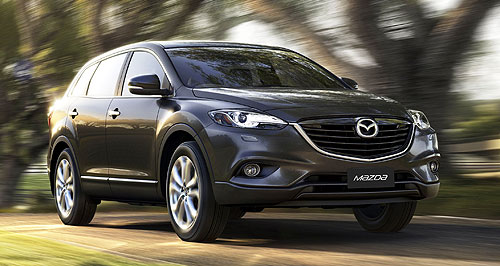Make / Model Search
Future models - Mazda - CX-9Next-gen Mazda CX-9 to downsizePower shift: The next-gen Mazda CX-9 could lose the Ford-sourced V6 that powers the current model (left). Mazda’s seven-seat CX-9 SUV could drop Ford V6 for four-pot turbo power11 Jun 2014 By BYRON MATHIOUDAKIS in JAPAN MAZDA’S CX-9 replacement is set to ditch its V6 engine in favour of a forced-induction four-cylinder petrol unit, bringing significantly lower fuel costs but no loss of performance. A replacement for the current model is still up to two years away from launching in Australia, as Mazda – a comparatively small company by global standards – has prioritised development of more globally relevant models such as the latest CX-5, Mazda6 mid-size range, Mazda3 small car, Mazda2 light car and the upcoming CX-3 crossover. The second-generation seven-seat family-sized SUV is again unlikely to offer a diesel option, due to its American-market focus where petrol remains king. While the replacement for the Ford-based 204kW/367Nm 3.7-litre V6 powertrain is likely to be based on a turbocharged version of the naturally aspirated four-cylinder SkyActiv G petrol engine serving the latest Mazda3, Mazda6 and CX-5, it remains unclear whether there will be a capacity increase from 2.5 litres to further boost torque output. What is certain is the CX-9 replacement – which could revive the CX-7 nomenclature to more accurately reflect its seven-seat configuration – is sure to be significantly lighter than the circa-2000kg six-year old TB-series it usurps under Mazda’s SkyActiv philosophy of greater efficiency. “There is no definitive answer as to where we are heading with that as yet and there are many determinants,” said Mazda Australia PR manager Steve Maciver at the company’s brand immersion event in Hiroshima earlier this month. “It is clear that the 2.5-litre four-cylinder engine in its current form would have to potentially do more when it comes to powering a CX-9, but we can’t confirm what that will be just yet. “The important factors here are not whether it has a four-cylinder or six-cylinder engine… but rather what are the outputs, what the fuel economy is, and what the car is like to drive.” Mazda Australia managing director Martin Benders added that whatever the choice is, it will be the right one for buyers in the large SUV class. “Based on (our) research, we know what sort of performance we need to deliver,” he said. However, with Mazda Motor Corporation (MMC) vice chairman, Seita Kanai, telling Australian journalists that the company is committed to providing vehicles ranging from just over one litre for the Mazda2 through to “over” three litres for the CX-9, there may still be a six-cylinder engine option in the flagship SUV’s future after all. “Smaller-sized engines a little bit over 1.0L engine in vehicles from Mazda2 to an over-3.0-litre V6 in the CX-9 – within this range, there is potential for us to deploy a variety of things within that area,” Mr Kanai said through a translator. In its two biggest markets last year – North America and Australia – the CX-9 found about 25,000 and 4500 buyers respectively, meaning that the cost of developing a standalone six-pot powerplant is prohibitive. As a result, Mazda may elect to use somebody else’s engine to appease US demand for a powerplant with more than four cylinders. Likewise, with Western Europe currently not taking the SUV, the same applies for any diesel installation – despite a desire from Mazda Australia for one. “We would love to offer a CX-9 diesel,” Mr Benders said. Whatever is decided, the CX-9 replacement’s 2016 launch will cap off a hectic four-year period for Mazda, where 80 per cent of its total line-up will have debuted the SkyActiv chassis, body and drivetrain technology. The first SkyActiv model was the CX-5 (early 2012), followed by the Mazda6 (December 2012), Mazda3 (January 2014), and Mazda2 (October 2014). Next year will also see an all-new MX-5 as well as the highly anticipated CX-3 compact SUV. The only non-SkyActiv models will be the BT-50 pick-up truck – which remains a joint venture with former majority shareholder Ford as it evolves with a facelift later next year – while Suzuki will continue to provide a range of ‘kei’ micro city cars to fill out Mazda’s domestic market requirements. Additionally, in China and some other emerging markets, older models such as the earlier Mazda6 generations and CX-7 are still available.  Read more6th of June 2014  Mazda makes NVH breakthroughFuture Mazdas to benefit from noise-path quelling technology to reduce NVHAll future modelsCX-9 pricing
Motor industry news |
Click to shareMazda modelsResearch Mazda All future modelsCX-9 pricing
Motor industry news |



 Alfa Romeo
Alfa Romeo Abarth
Abarth Audi
Audi Aston Martin
Aston Martin BMW
BMW Bentley
Bentley Ferrari
Ferrari Chevrolet
Chevrolet Ford
Ford Fiat
Fiat GWM
GWM Foton
Foton Hyundai
Hyundai Honda
Honda Jaguar
Jaguar Isuzu
Isuzu Kia
Kia Jeep
Jeep Land Rover
Land Rover Lamborghini
Lamborghini Maserati
Maserati Lexus
Lexus McLaren
McLaren Mazda
Mazda Mercedes-Benz
Mercedes-Benz Mitsubishi
Mitsubishi Mini
Mini Peugeot
Peugeot Nissan
Nissan Ram
Ram Porsche
Porsche Rolls-Royce
Rolls-Royce Smart
Smart Skoda
Skoda Suzuki
Suzuki Subaru
Subaru Toyota
Toyota Tesla
Tesla Volvo
Volvo Zeekr
Zeekr







Facebook Twitter Instagram